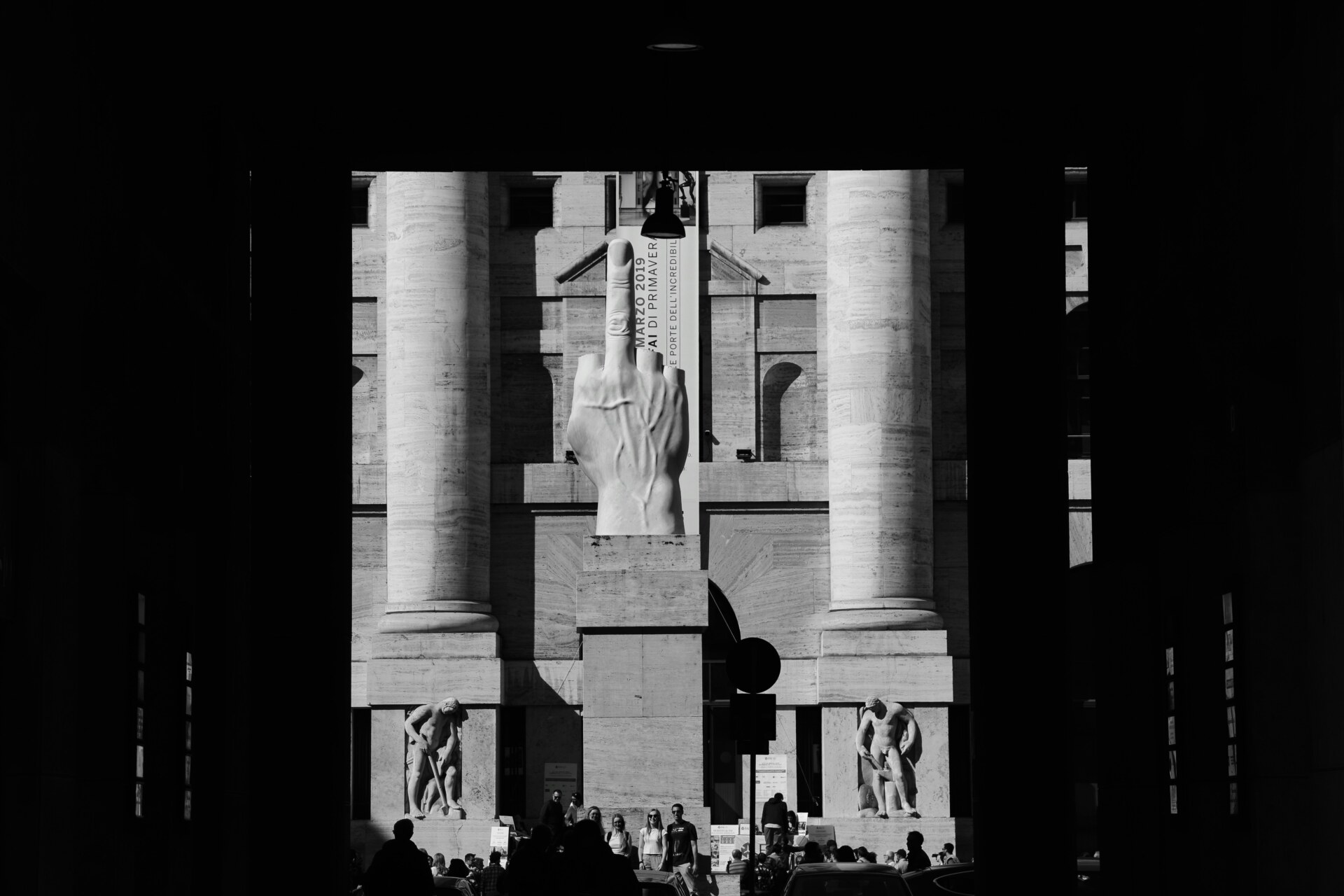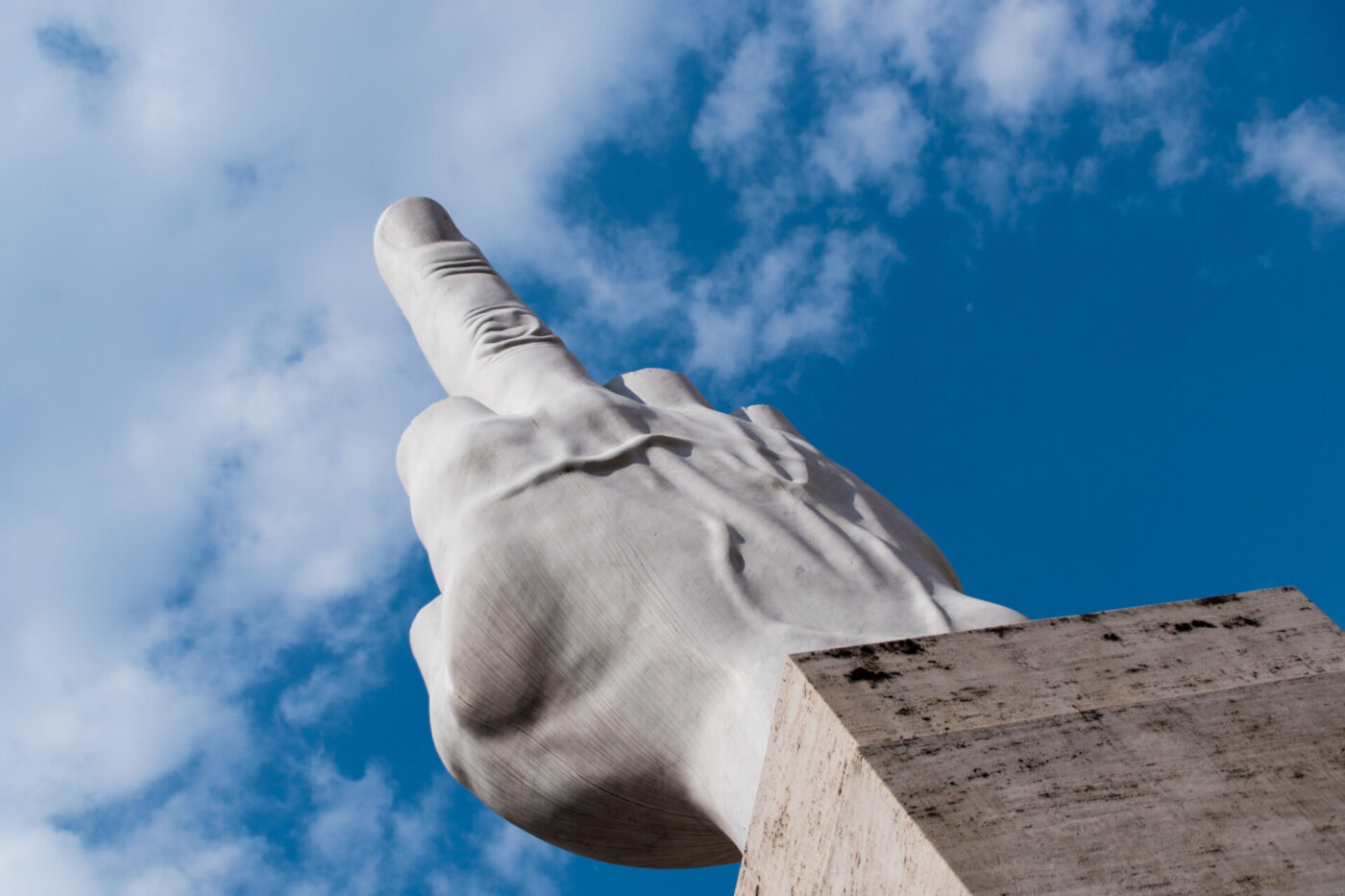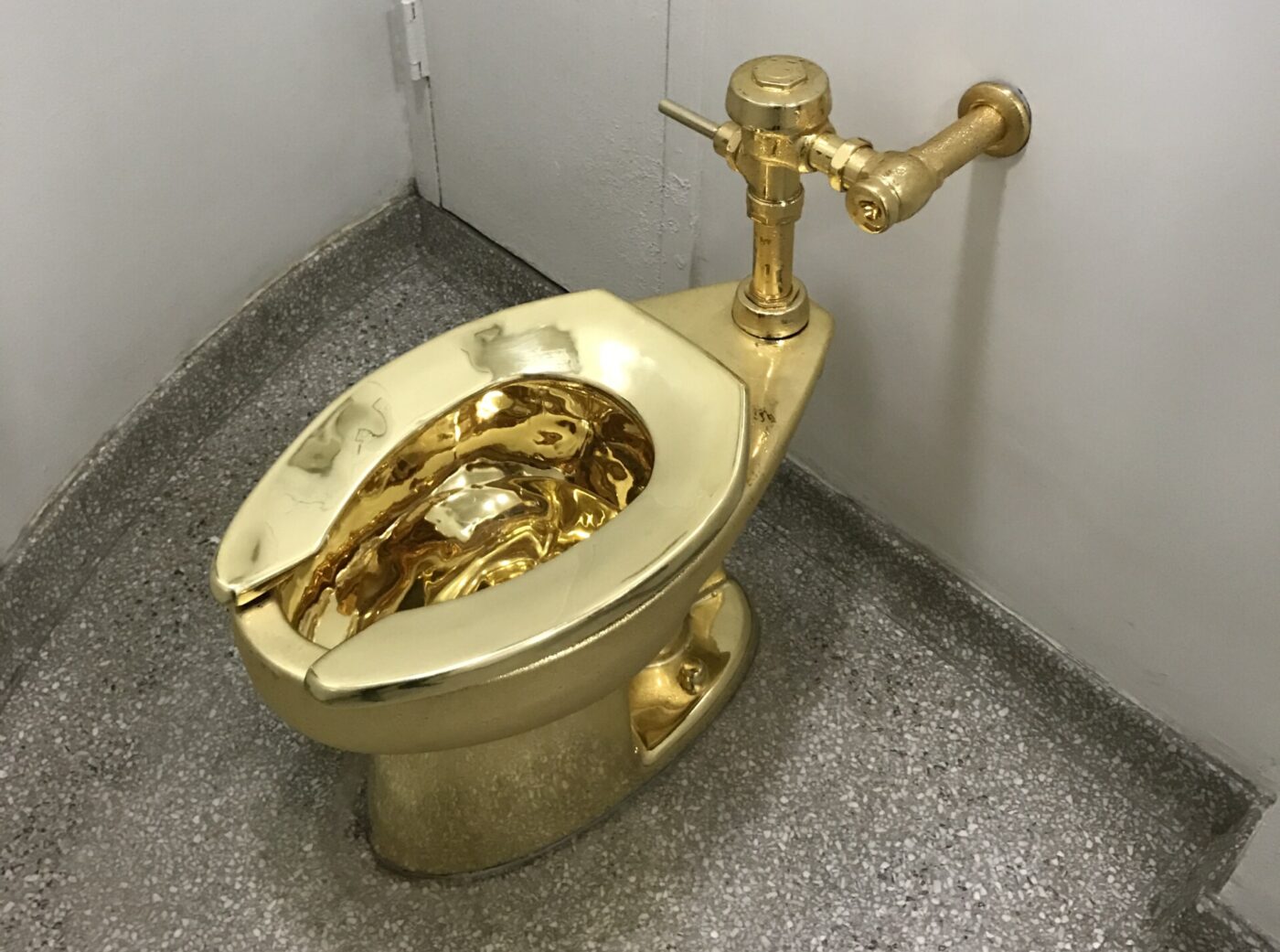A word of warning: If you take an aimless stroll through the center of Milan and find yourself in Piazza Affari, you will get flipped the bird. No, not by a person–though Italians are known to love their hand gestures–but rather, by an art piece. In the center of the square stands a 36 ft (11m) tall statue of a middle finger situated in front of the historic Palazzo Mezzanotte, home to the Italian Stock Exchange. This towering middle finger–a universally recognized symbol of defiance and disrespect–is made of fine white Carrara marble, the same material used in Michelangelo’s David. Forged in a classical style, the statue could easily blend in with the surrounding architecture, if not for the fact that it is, in fact, a giant middle finger. And, to uncover the story and discourse behind this statue, commonly referred to as “Il Dito” or “Il Dito Medio,” is to gain some insight into the spirit of Milan itself.

L.O.V.E, or 'Il Dito', in front of Milan's Stock Exchange building
Il Dito’s formal title is L.O.V.E –an acronym for “Libertà, Odio, Vendetta, Eternità” (“Freedom, Hatred, Revenge, Eternity”)–and is the work of the New York-based Paduan artist Maurizio Cattelan. If there’s one thing you could say about the artist, it’s that he loves a good joke and some good controversy. Cattelan’s oeuvre is full of satire, humor, and provocation. Take, for instance, La Nona Ora, a sculpture of Pope John Paul II being struck by a meteorite; or Turisti, Cattelan’s installation of 200 stuffed pigeons (and corresponding excrement) at the Venice Biennale; or his well-known exhibition of a gold toilet at the Guggenheim Museum in New York, titled America (2016 – 2017). In most instances, Cattelan likes his work to be in dialogue with its surroundings, and his choice of exhibition location is typically intentional.
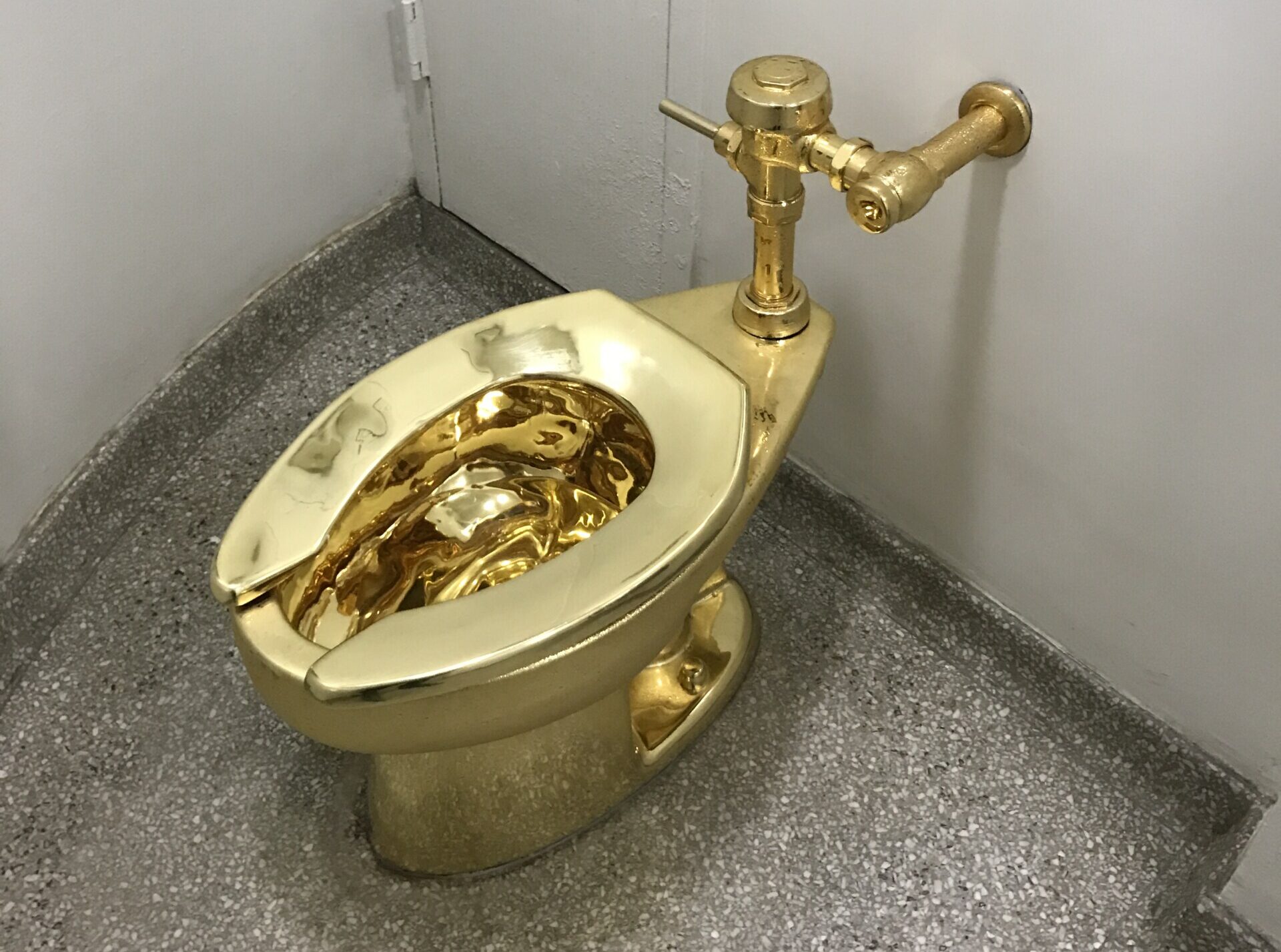
"America, 2016" by Cattelan
In the case of Il Dito, with its placement in front of the Italian Stock Exchange, the objective, at first, appears to be a protest of the banking industry–especially striking when one sees the finger juxtaposed against the formal lettering of the word “Borsa” (the Italian term for stock exchange) on the main doors of the building. Such an interpretation would make the most sense, especially given the work was completed in the wake of the global financial crisis of 2008, when many major banks caused a worldwide economic meltdown after years of taking on excessive risk.
But when you take a closer look at the statue, you’ll realize that the rest of the fingers on the hand are not flexed as if to flip the bird, but rather, severed as if vandalized or destroyed to time. Picture what it might look like with the fingers back in place, and you would see a full hand raised in the air: the Roman salute, a gesture commonly linked to Italy’s Fascist movement. The sentiment comes into full view when you dive deeper into the history of the building it sits in front of. The Palazzo Mezzanotte, which was completed in 1932 at the height of Mussolini’s power, remains an architectural symbol of the Fascist era, embodying a peculiar mix of neo-classical and 20th-century rationalist styles that were popular at the time. Through a careful construction of the object in relation to its location, this cheeky, irreverent provocation suddenly takes on deeper, more political meaning as a denouncement of Italy’s Fascist past.
In the interest of leaving everything open to interpretation, Cattelan remains coy about L.O.V.E. and has never fully disclosed the meaning of his work. When pressed by reporters, he flatly denied an affront to Italy’s bankers (“I have nothing against the Stock Exchange. I’m not giving the bird to anybody.”) but encouraged viewers to derive their own meaning. “Above all, imagination,” he said. “The imagination of everyone, of those who have it.”
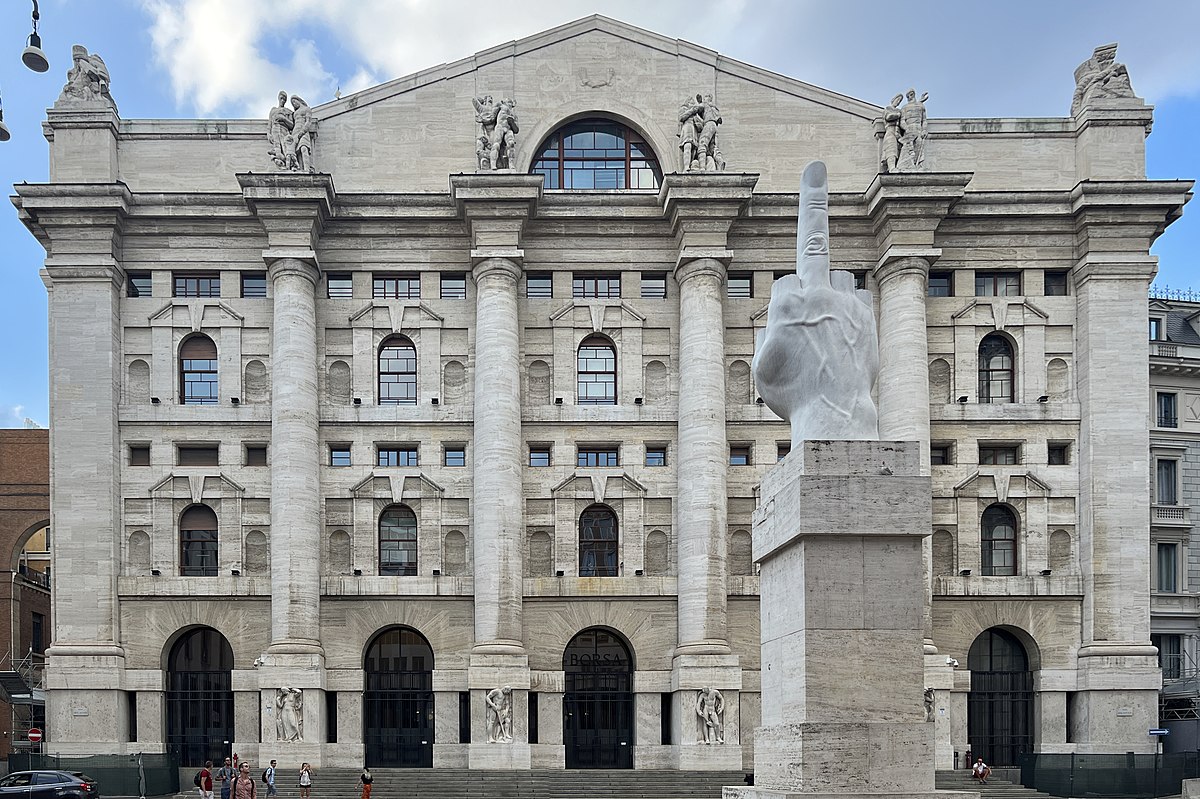
Palazzo Mezzanotte
As with all great art, we may never really know. What we do know is that Cattelan insisted on the spectacle of making Piazza Affari the sculpture’s first home, offering the work to the city of Milan for a temporary period. A few months before its premiere, Cattelan said to a reporter: ‘‘I have some pictures in my mind. I can see the mayor unveiling the sculpture. It could be quite a … funny moment.”
The sitting mayor, Letizia Morrati, championed the installation to a very skeptical city council in the interest of bringing more contemporary public art to Milan. After much persuasion, L.O.V.E was unveiled in September 2010, with the idea that the statue would be on display in Piazza Affari for only two weeks. Naturally, it provoked mixed reactions from the Milanese–some called it “an insult to centuries of Italian art.” Others considered it courageous. “This is a very brave thing to do,” one said. “You can’t see this everywhere.” But it appears that most reveled in the controversy and humor. “Let’s just say it’s symbolic,” laughed one passerby. Enough people were so delighted by Il Dito that over 1,800 signed a petition addressed to Morrati and other city leaders requesting to keep it in Piazza Affari.
The city kept extending the installation, and soon enough, the decision was made to keep the sculpture on display permanently. In just over a decade, Il Dito has become as much of a fixture in Piazza Affari as the architecture surrounding it, and remains a conversation piece for visitors and locals alike. At various times, people have built on the conversation by using Piazza Affari and Il Dito as a backdrop for protests, strikes, and demonstrations. In a moment of controversy provoking more controversy, a local street artist named Ivan Tresoldi painted Il Dito’s nail pink, without permission, as a sign of protest linked to International Women’s Day. Tressoldi claimed: “I wanted to break a taboo, to what extent can you touch the work of another artist?” Cattelan hasn’t commented, but one might imagine that he’d appreciate the gesture.
It’s only fitting for this kind of art to exist in Milan, a city that has, over and over, defiantly denounced its past to move towards the future. Milan’s streets, culture, and people reflect an evolving, yet productive, tension between old and new, ancient and modern, that’s rarely seen elsewhere in the country. Whereas other cities across the peninsula prefer to put their rich history on display, the Milanese are not afraid to take risks, constantly working to redefine what being Italian means. L.O.V.E., just one piece of the city’s contemporary art canon, represents these themes as well. The art both blends in and stands out. It mimics style to pay homage to history and to reject it.
Or, perhaps, it’s not all that complicated. A middle finger is a middle finger, after all.
